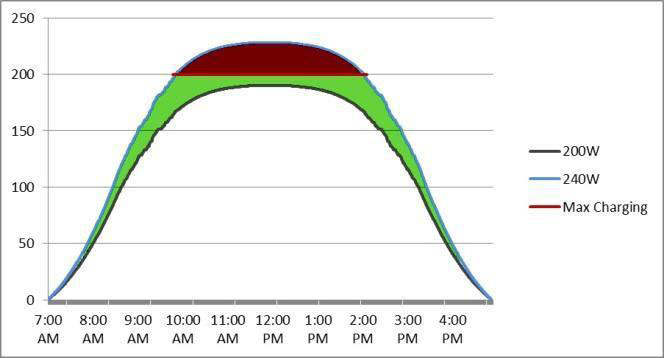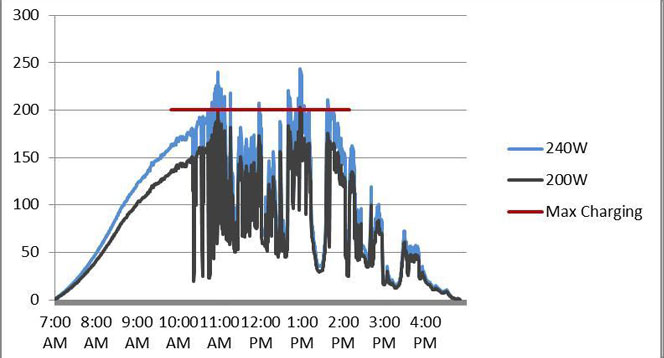This tech tip relates to the impact that Morningstar’s TrakStar™ MPPT Technology has on PV Module Sizing and Power Ratings. You can improve performance and reduce costs for systems that would otherwise suffer from reduced power input and inconsistent levels of charging. A PDF file is available for this tech tip and you can download your copy here.
TIP: You can size your PV array input power to the Morningstar MPPT controllers well above the controller’s Maximum Nominal Solar PV Wattage Input rating without damaging the unit, and without causing the charging current to exceed the maximum output current rating.
The controller can limit output current and will run at 100% of rated current output and not higher. The controller was designed with this power-shaving capability, and when oversized, it does not void the warranty.
This graph illustrates the output power levels of a SunSaver MPPT controller—comparing a 200W module to a 240W module—operating on a clear & sunny day at STC maximum power (Pmp).
- Though the power being delivered to the battery is limited to 200W and the red area at the top of the production curve is lost, the larger module is harvesting more energy, as shown in green.
- The larger module will provide better production with no power-shaving early and late in the day as compared to a smaller module.
- In this case almost twice as much energy is gained (green area) than lost (red area) with 12.5% more energy available to charge the batteries than the 200W module.

SS-MPPT-15L (240W vs. 200W module) on a Clear Day
On cloudy (or intermittent sunny) days there will be little or no power-shaving and the extra power will serve the battery well with more energy harvest. This graph uses real array data and is scaled to a 200W module and a 240W module.
- On this day there is < 1% loss due to power-shaving (energy above the red line), so more than 95% of the excess power over 200W can be utilized for charging.
- On clear days this loss of power is likely not to be missed so much.
- One exception to note is where the power-shaving energy loss could be more of a factor—in colder climates with winter tilt.- In these conditions (shorter days, colder temperatures and okay ≈90° incidence angles) the array will operate above STC Max.- Power Levels and the loss of power could have a bigger impact during the time of the year when it is most needed.
- Also, to avoid unnecessary stress on the controller’s electronic components, it is recommended that when the controller is installed in a sustained warm temperature climate, the controller not operate at full power, close to its maximum ambient temperature, for prolonged periods of time.

SS-MPPT-15L (240W vs. 200W module) on an Intermittent Day
Morningstar’s MPPT controllers can operate with an oversized array that is several times larger than the maximum Nominal Solar PV ratings, while still limiting the maximum battery current to the controller’s maximum current rating. Many other MPPT controllers on the market cannot react quickly enough for fast changes in solar conditions. Even at the published maximum power levels, these controllers are known to exceed their maximum output current ratings and can trip the overcurrent protection fault shutting off the controller during high power conditions.
